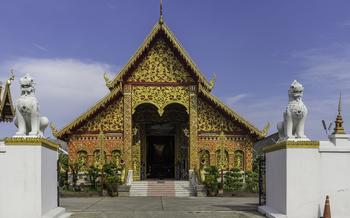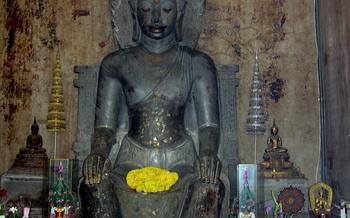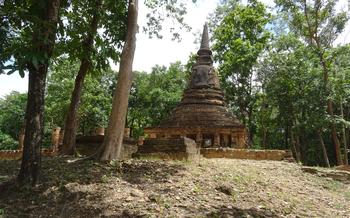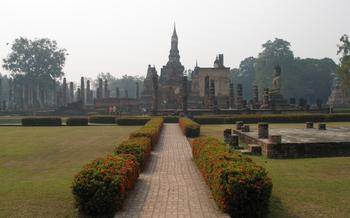
Wat Chonthara Singhe
- Wat Chonthara Singhe: A Spiritual Haven
- Exploring the Temple Grounds
- Paying Homage to the Buddha
- Marveling at the Architecture
- Unveiling the History
- Participating in Festivals
- Seeking Spiritual Guidance
- Learning About Buddhism
- Volunteering and Giving Back
- Exploring the Surroundings
- Capturing the Beauty
- Respecting Local Customs
- Planning Your Visit
- Transportation and Getting There
- Insider Tip: Unveiling a Hidden Gem
Wat Chonthara Singhe: A Spiritual Haven
Wat Chonthara Singhe, nestled amidst the serene landscapes of Narathiwat, Thailand, is a resplendent temple that exudes a profound sense of spirituality and tranquility. Its history dates back to the 19th century when it was established as a center for Buddhist teachings and practices. Over the years, the temple has undergone several renovations and expansions, culminating in its current grandeur.
Architectural Features and Unique Characteristics: Wat Chonthara Singhe stands as a testament to the fusion of traditional Thai and Khmer architectural styles. Its towering spires, adorned with intricate carvings, reach towards the heavens, while the golden stupas, glimmering under the sunlight, symbolize the enlightenment of the Buddha. The temple's unique characteristics include a magnificent reclining Buddha image, a sacred footprint of Buddha, and a collection of ancient Buddhist artifacts.
Religious Ceremonies and Festivals: Wat Chonthara Singhe is a vibrant hub of religious activities and festivals throughout the year. Devotees and visitors gather to participate in daily prayers, meditation sessions, and chanting rituals. The temple also hosts several significant festivals, including the annual Visakha Bucha Day, which celebrates the birth, enlightenment, and passing of Buddha. During these festivals, the temple comes alive with vibrant processions, colorful decorations, and a palpable sense of devotion.
Etiquette and Customs: When visiting Wat Chonthara Singhe, it is essential to observe proper etiquette and customs to show respect for the sacred nature of the temple. Visitors should dress modestly, covering their shoulders and knees, and remove their shoes before entering the temple grounds. It is customary to bow or wai in front of Buddha images and monks as a sign of reverence. Additionally, it is considered inappropriate to point at or touch Buddha images.
Exploring the Temple Grounds
Wat Chonthara Singhe's beautifully landscaped grounds invite exploration and contemplation. As you wander through the temple complex, you'll encounter a captivating array of structures, each with its own unique significance and charm. The main temple building, known as the ubosot, is a stunning example of traditional Thai architecture, adorned with intricate carvings and colorful murals depicting scenes from the life of Buddha. Within the ubosot, you'll find a revered Buddha image seated in a serene and meditative pose.
Beyond the ubosot, the temple grounds are home to several other notable structures, including a bell tower, a library, and a meditation hall. The bell tower, with its towering spire, is a prominent landmark and a symbol of the temple's spiritual presence. The library houses a collection of ancient scriptures and religious texts, providing a glimpse into the rich history and teachings of Buddhism. The meditation hall offers a tranquil space for visitors to find inner peace and connect with their spirituality.
As you explore the temple grounds, you'll also discover a number of sacred relics and artifacts enshrined at the temple. These include ancient Buddha images, ceremonial objects, and relics of revered monks. These relics are not only of historical and cultural significance, but also serve as objects of devotion and veneration for the faithful.
The tranquil gardens that surround the temple buildings add to the serene atmosphere of Wat Chonthara Singhe. Lush greenery, colorful flowers, and gently flowing water features create a peaceful and harmonious environment. Visitors can take a leisurely stroll through the gardens, enjoying the natural beauty and finding respite from the hustle and bustle of everyday life.
Paying Homage to the Buddha
At the heart of Wat Chonthara Singhe lies a revered Buddha image, emanating an aura of serenity and spirituality. Believed to date back to the 19th century, this sacred statue holds immense significance for devotees and visitors alike. The Buddha image is adorned with intricate gold leaf and precious jewels, symbolizing the enlightenment and compassion of the Buddha.
Pilgrims and worshippers gather before the Buddha image to pay homage and seek blessings. They offer flowers, candles, and incense as tokens of their devotion. The temple also provides an opportunity to make merit, a Buddhist practice of accumulating good karma through acts of generosity and kindness. Devotees can donate money or other offerings to the temple, contributing to its upkeep and the well-being of the resident monks.
For those seeking a deeper spiritual connection, Wat Chonthara Singhe offers meditation and chanting sessions. These sessions are led by experienced monks who guide participants in mindfulness practices, helping them to find inner peace and tranquility. Through these meditative practices, visitors can deepen their understanding of Buddhist teachings and cultivate a sense of compassion and loving-kindness.
Marveling at the Architecture
Wat Chonthara Singhe showcases a mesmerizing blend of architectural styles, reflecting the diverse cultural influences that have shaped Narathiwat over the centuries. The temple's main structures, including the ubosot (ordination hall), viharn (assembly hall), and chedi (stupa), exhibit a harmonious fusion of Thai, Khmer, and Chinese architectural elements.
The ubosot, the most sacred building in the temple complex, is adorned with intricate carvings and sculptures depicting scenes from Buddhist mythology. The roof is supported by massive pillars featuring delicate floral motifs, while the gables are adorned with intricate designs and colorful ceramic tiles.
The viharn, where monks gather for daily prayers and ceremonies, is equally impressive. Its interior is adorned with vibrant murals depicting the life of Buddha and significant events in Buddhist history. The walls are lined with rows of Buddha images, each with unique features and expressions.
The chedi, a towering monument symbolizing the Buddha's enlightenment, is a prominent landmark in the temple grounds. Its base is adorned with intricate stucco reliefs depicting scenes from the Buddha's life, while the spire is topped with a golden stupa that glistens in the sunlight.
The combination of these architectural styles creates a visually stunning ensemble that reflects the rich cultural heritage of Narathiwat. Each structure tells a story, inviting visitors to explore the depths of Thai, Khmer, and Chinese influences that have shaped the region's unique identity.
Unveiling the History
Wat Chonthara Singhe's origins can be traced back to the early 19th century, when a group of devout Buddhists led by a revered monk named Phra Kru Uttamamuni founded the temple. According to local legends, the site of the temple was chosen due to its auspicious location and serene atmosphere, believed to be conducive to spiritual practice and meditation.
Over the years, Wat Chonthara Singhe has played a pivotal role in the religious life of the Narathiwat community. It has served as a center for Buddhist teachings, ceremonies, and festivals, fostering a deep connection between the temple and the local people. The temple has also been instrumental in preserving and promoting Thai culture and traditions, organizing events, and activities that showcase the rich heritage of the region.
In the mid-20th century, Wat Chonthara Singhe underwent significant renovations and expansions, led by a dedicated abbot who sought to enhance the temple's facilities and accommodate the growing number of devotees. New structures were constructed, including a grand ubosot (ordination hall), a viharn (assembly hall), and a chedi (stupa), each adorned with intricate carvings and vibrant murals depicting scenes from Buddhist mythology.
Throughout its history, Wat Chonthara Singhe has faced various challenges, including natural disasters and political upheavals. However, the temple has persevered and remained a beacon of hope and resilience for the community. Preservation and restoration efforts have been continuously undertaken to maintain the temple's architectural integrity and preserve its cultural significance for future generations.
Participating in Festivals
Wat Chonthara Singhe is renowned for its vibrant festivals and celebrations that attract devotees and visitors from all over. The most prominent festival is the annual Bun Phra That held during the full moon of the sixth lunar month. This grand festival features a spectacular procession of elaborately decorated floats, lively music, and traditional performances. Devotees carry offerings and participate in merit-making ceremonies, seeking blessings and good fortune for the year ahead.
Other notable festivals include Makha Bucha, commemorating the Buddha's first sermon, and Visakha Bucha, celebrating the Buddha's birth, enlightenment, and passing into Nirvana. These festivals are marked by chanting, meditation, and special ceremonies that honor the teachings and life of the Buddha. Participating in these festivals offers a glimpse into the rich cultural and religious traditions of Thailand and allows visitors to immerse themselves in the festive atmosphere.
Seeking Spiritual Guidance
At Wat Chonthara Singhe, visitors have the opportunity to connect with the resident monks and seek spiritual guidance. These monks play a vital role in the temple community, offering teachings, counseling, and guidance to those who seek it. With their deep knowledge of Buddhism and their compassionate nature, the monks are dedicated to helping individuals on their spiritual journey.
For those seeking a deeper understanding of Buddhism and its teachings, the monks at Wat Chonthara Singhe are available to provide guidance and instruction. They offer classes, workshops, and meditation retreats, where visitors can learn about Buddhist principles, practices, and meditation techniques. Through these teachings, individuals can gain insights into the nature of the mind, the causes of suffering, and the path to enlightenment.
The monks at Wat Chonthara Singhe also offer spiritual counseling and guidance to those facing challenges or seeking direction in their lives. With their wisdom and compassion, they can provide a listening ear, offer advice, and help individuals navigate difficult times. Through their teachings and guidance, the monks aim to help visitors find inner peace, clarity, and a deeper connection to their spiritual selves.
Learning About Buddhism
Wat Chonthara Singhe is not just a place of worship; it's also a center for learning and understanding Buddhism. The temple offers a range of classes, workshops, and seminars that delve into the teachings of Buddha and their relevance in modern life. These sessions are conducted by knowledgeable monks and experienced practitioners who share their insights and wisdom with visitors.
Whether you're a seasoned Buddhist practitioner or simply curious about the religion, these classes provide an excellent opportunity to deepen your understanding. You'll learn about Buddhist principles, practices, and meditation techniques that can help you find inner peace and happiness.
The temple also encourages interaction between visitors and monks, allowing you to ask questions, seek guidance, and engage in meaningful discussions. These interactions offer a unique opportunity to gain firsthand knowledge and insights into the Buddhist way of life.
By immersing yourself in the teachings of Buddha at Wat Chonthara Singhe, you'll not only gain a deeper understanding of Buddhism but also discover practical tools and techniques to enhance your daily life and cultivate a more peaceful and fulfilling existence.
Volunteering and Giving Back
Wat Chonthara Singhe welcomes visitors who wish to volunteer their time and skills to contribute to the upkeep and maintenance of the temple. Volunteering is a rewarding way to give back to the community and immerse yourself in the temple's spiritual atmosphere.
Various volunteer opportunities are available, such as helping with gardening, cleaning, and assisting with temple events. You can also participate in community service projects organized by the temple, such as food drives, clothing donations, and educational programs.
Volunteering at Wat Chonthara Singhe is a fulfilling experience that allows you to connect with the local community, learn about Thai culture, and make a positive impact on the temple's preservation and growth. The monks and staff are grateful for the support of volunteers and will gladly guide and assist you throughout your stay.
Whether you have a few hours or a few weeks to spare, volunteering at Wat Chonthara Singhe is a meaningful way to contribute to the temple's vibrant community and make a lasting difference.
Exploring the Surroundings
Situated in the vibrant province of Narathiwat, Wat Chonthara Singhe is surrounded by a wealth of captivating attractions that offer a glimpse into the region's rich history, natural wonders, and cultural heritage. Within easy reach of the temple, visitors can embark on day trips to explore historical sites, marvel at stunning natural landscapes, and immerse themselves in the unique customs and traditions of the local communities.
For those seeking a deeper connection with the region's past, Narathiwat National Museum is a must-visit destination. This treasure trove of historical artifacts houses exhibits that shed light on the province's fascinating past, from its ancient origins to its role in modern-day Thailand. Visitors can also journey to the nearby Ban Tha Saba Yoi Archaeological Site, where they can explore the remnants of an ancient civilization that once flourished in the area.
Nature enthusiasts will find solace in the pristine beauty of Khao Pu-Khao Ya National Park. This sprawling park boasts lush rainforests, towering waterfalls, and breathtaking viewpoints that offer panoramic vistas of the surrounding landscape. Visitors can embark on jungle treks, go birdwatching, or simply relax and soak in the tranquility of the natural surroundings.
To experience the vibrant culture of Narathiwat, head to the bustling Tak Bai Floating Market. This lively market offers a kaleidoscope of colors, sounds, and aromas as vendors display their wares on boats floating along the tranquil waters. Visitors can savor delicious local delicacies, shop for unique souvenirs, and witness the vibrant daily life of the local people.
For a truly immersive experience, consider venturing off the beaten path to explore hidden gems that lie just beyond the temple's vicinity. Wat Khao Kong, with its stunning hilltop location and intricate murals, is a hidden treasure that offers a glimpse into the region's Buddhist heritage. Thale Sap Songkhla, a vast freshwater lake, provides opportunities for boating, fishing, and birdwatching, while Ko Yao, a secluded island, offers pristine beaches, crystal-clear waters, and a laid-back atmosphere that is perfect for relaxation.
Whether you seek historical exploration, natural wonders, or cultural immersion, the surroundings of Wat Chonthara Singhe offer a wealth of experiences that are sure to enrich your journey and leave you with lasting memories of this vibrant and captivating region.
Capturing the Beauty
Wat Chonthara Singhe's stunning architecture and serene atmosphere present a photographer's paradise. To capture the temple's essence, arrive early in the morning or late in the afternoon when the soft light casts a warm glow on the structures. Utilize a wide-angle lens to encompass the temple's grandeur and experiment with different angles to showcase its unique features. Don't miss the intricate carvings and details that adorn the buildings, zooming in to highlight their craftsmanship. Remember to be respectful of the temple's sanctity and avoid using flash photography or causing disruptions during religious ceremonies. Share your captured moments with others, inspiring them to embark on their own journey of discovery and appreciation for this sacred haven.
Respecting Local Customs
When visiting Wat Chonthara Singhe, it is essential to be mindful of local customs and etiquette to ensure a respectful and harmonious experience. Dressing appropriately is crucial; avoid revealing or overly casual clothing. Both men and women should cover their shoulders and knees. Upon entering the temple, remove your shoes and place them neatly in the designated racks.
While inside the temple, maintain a respectful demeanor. Avoid loud noises, refrain from pointing your feet towards Buddha images, and always keep your head lower than the Buddha's. When making offerings, follow the guidance of the monks or temple staff. Remember to be respectful and mindful of the sacredness of the temple grounds.
Planning Your Visit
Best Time to Visit: - Aim for the cooler months (November to February) to avoid sweltering heat. - Consider visiting during festivals (e.g., Songkran) for a lively and immersive experience.
Temple Hours: - Wat Chonthara Singhe is typically open from 8 am to 5 pm daily. - Confirm the exact hours with the temple or local authorities before your visit.
Admission Fees: - Admission is free for all visitors. - Donations are welcome and contribute to the temple's upkeep and community projects.
Guided Tours: - Guided tours are available upon request. - Contact the temple in advance to arrange a guided tour in your preferred language.
Facilities and Amenities: - Basic amenities like restrooms and drinking water are available. - There may be limited dining options, so consider bringing snacks or planning meals elsewhere.
Accessibility: - The temple grounds are generally accessible, but some areas may require assistance for wheelchair users. - Contact the temple to inquire about specific accessibility needs.
Transportation and Getting There
Reaching Wat Chonthara Singhe is a breeze with various transportation options at your disposal. Public transportation enthusiasts can hop on a local bus or songthaew, the iconic Thai shared taxis, which will drop you right at the temple's doorstep. Alternatively, taxis are readily available for hire, offering a more personalized and direct journey. For those seeking independence and flexibility, renting a car is an excellent choice, allowing you to explore the temple at your own pace and venture into the surrounding areas.
Regardless of your chosen mode of transport, getting to Wat Chonthara Singhe is straightforward. Simply follow the signs or ask for directions from the locals, who are always eager to assist. Ample parking space is available within the temple grounds, ensuring a hassle-free visit. However, navigating the traffic in Narathiwat, especially during peak hours, requires patience and caution. Embrace the local driving culture, characterized by a blend of chaos and courtesy, and you'll find your way to the temple without any hiccups.
Insider Tip: Unveiling a Hidden Gem
Beyond the renowned Wat Chonthara Singhe, Narathiwat holds a hidden gem waiting to be discovered—Wat Huay Plu. Nestled amidst tranquil surroundings, this lesser-known temple exudes an aura of serenity and spirituality. Its unique charm lies in its intricate wood carvings, depicting mythical creatures and scenes from Buddhist mythology.
Take a stroll through its serene grounds, marveling at the craftsmanship and symbolism embedded in each carving. Immerse yourself in the tranquility of the temple's atmosphere, free from the throngs of tourists.
To reach this hidden gem, inquire with the locals or take a short taxi ride from Wat Chonthara Singhe. Embrace the opportunity to explore beyond the beaten path and discover the hidden treasures of Narathiwat.






